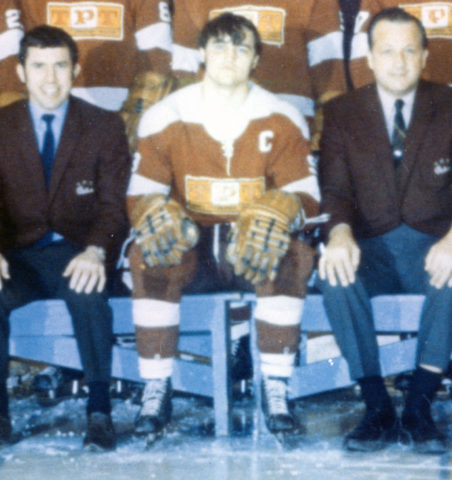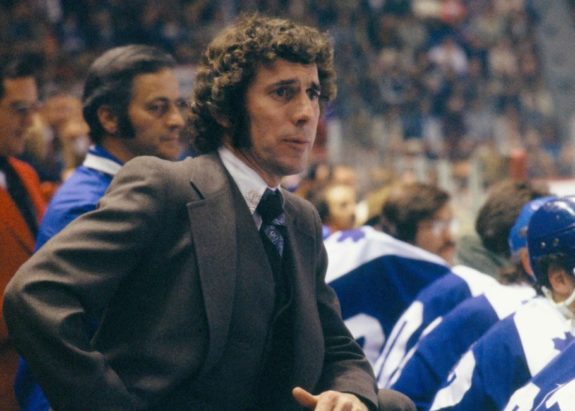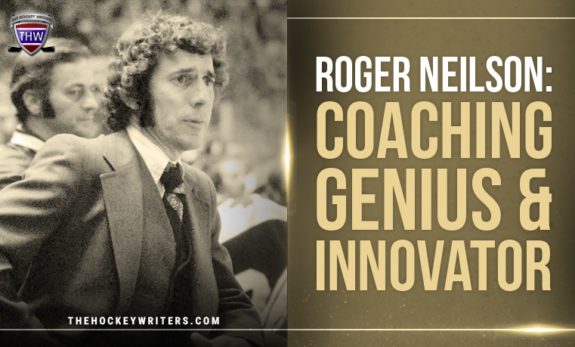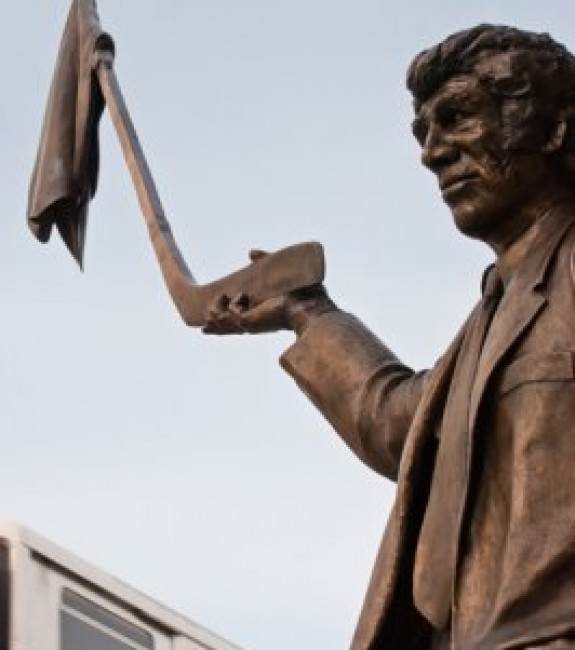The late Roger Neilson will forever go down as one of the most unique coaches in NHL history. His style, personality, and willingness to do anything to gain an upper hand is the stuff of legends. He was an innovator who was responsible for many of the rules the NHL has today because he just knew how to exploit a loophole in the rule book. On top of all that, he also inspired Towel Power, which is practiced in rinks to this day.
Neilson was not only a genius in the coaching world, but he was also an amazing human being, loved by players, fans, and coaches alike. So, with all that in mind, let’s take a look at a coaching career that continues to dot the fabric of the game we all enjoy today.
Neilson’s Innovations Started Early
Neilson didn’t take long to enact his brilliance in the hockey world. Just like most coaches, his career didn’t start in the NHL. It began in the Ontario Hockey Association (OHA) with the Peterborough Petes where he spent nine seasons before making the jump to the big leagues. In that time he accumulated 276 wins and one championship in 1971-72. Though the wins are not the reason he is in the history books. During his tenure in the OHA, he put forth three of his more bizarre coaching strategies ever.

Neilson was an intense student of the game, so he knew all the ins and outs of the rule book. Because of this, he was able to exploit various loopholes within it. One of them was intentionally putting too many men on the ice in the dying minutes of a game. When the other team was pressing for a goal, he would interrupt the flow by forcing the referee to call a penalty. Another was telling his goaltender to put his stick or a mound of snow in the crease before he got pulled for an extra attacker, thus preventing easy empty-net goals.
Finally, whenever Neilson’s teams had a penalty shot against them, he put a defenceman in place of the goaltender. His strategy was to have him rush the forward, creating a one-on-one situation rather than a breakaway. More often than not, the defenceman would take the puck away or force the forward to lose control of it. He was able to do this because the rule book never stated that the goaltender couldn’t leave the crease or that you had to keep him in the net at all. These loopholes were all closed with new rules, not only in the OHA but in the NHL as well, but they were only created because Neilson had the wherewithal to try new things to gain the upper hand.
Neilson’s Time with the Maple Leafs
Neilson’s debut with the Toronto Maple Leafs in 1977 was met with anticipation and excitement. His innovative and unique style of coaching carried them to the Conference Finals after a 41-29-10 regular season.

During that same season, Neilson introduced one of the biggest innovations in the game today, the use of video and statistics to prepare for an opponent. While not at the same technological or mathematical extent it is now, he once again used his genius to attempt to gain the upper hand.
In addition to this, he also taught players the importance of off-ice conditioning, and many other techniques like faceoff plays, the tracking of scoring chances, and line matching. He was basically the first coach to use analytics to win games.
All that had to start somewhere…We were all packed in a little room under the stands at the Gardens when he showed us those first videos, on a basic TV, going over power play and penalty killing.
It was new, but refreshing and I was all for it. Roger also introduced us to proper off ice conditioning, got us working on face-off plays and he probably came up with the first (defined chart) of scoring chances. Mostly, he made you accountable, to be prepared for every night like it was Game 7 of the Stanley Cup final.
Former Maple Leafs forward Darryl Sittler (from ‘Legendary bench boss Roger Neilson remembered’, Toronto Sun – 9/16/17)
All of this got Neilson the nickname “Captain Video” and started something that is used in every NHL dressing room today. There are even coaches that are fully dedicated to the role. Neilson did it all on a VCR instead of the state-of-the-art computers and tablets that everyone now enjoys.
Neilson’s time with the Maple Leafs certainly started out well, but patience was not a virtue of Leafs’ owner Harold Ballard. After succeeding in the playoffs the previous season, the Leafs’ second season under him was not as positive. In the midst of a relatively short four-game losing streak down the stretch, the Leafs’ infamous owner got fed up with his “school-boy hockey” and ended up firing him along with his assistant Al Dunford.
The problem was, Ballard had no one lined up to replace him. That led to a three-day soap opera that culminated with him re-hiring his former head coach. Outrage from players and fans as well as negative press swayed him to change his mind about firing the beloved Neilson.
Tiger Williams was the most instrumental in what happened there…He was a real team guy and always had a good relationship with Harold.
Darryl Sittler (from ‘A look back at the Roger Neilson ‘paper bag’ game and Pal Hal’s theatre of the absurd’, Toronto Sun – 3/11/19)
However, Ballard wanted him to wear a paper bag to create drama for his return. He ultimately refused and walked out to a standing ovation from the fans. The Leafs made the playoffs under Neilson and bowed out in the second round, leading Ballard to once again re-evaluate the status of his head coach. He, of course, fired him again, this time for good. Despite the early success Neilson had with the Maple Leafs, the paper-bag incident will, unfortunately, remain a part of his legacy.
Neilson’s Brief Time with the Buffalo Sabres
Neilson’s time on the unemployment line only lasted one day, as he was hired by legendary head coach Scotty Bowman to become his assistant with the Buffalo Sabres for the 1979-80 season.

After one season, Neilson was promoted to head coach as Bowman was elevated to general manager. He subsequently led the Sabres to a 39-20-21 record before bowing out in the second round once again, this time to the Minnesota North Stars. His tenure only lasted one season, as they mutually decided to part ways at the conclusion of the 1980-81 campaign. After he was dismissed, Neilson cited personal differences with Bowman.
It wasn’t something that just happened suddenly…I don’t think you could automatically expect two people to hit it off just right in their personalities and philosophies and so on. We just didn’t hit it off.
Roger Neilson (from ‘Sabres Buy Out Contract Of Neilson, Head Coach’, New York Times – 5/2/81)
Related: Sabres Goalie Rocky Farr Recalls Memories From Early Buffalo Teams
Both men had very strong personalities, so I am not surprised that they didn’t get along. Neilson was also very stubborn and wanted to do things his way, which probably got under the skin of Bowman.
Neilson’s Canucks & Towel Power
After his brief stint with the Sabres, Neilson took over as associate coach with the Vancouver Canucks in 1981, and little did he know at the time, to become one of their most iconic head coaches of all-time. He didn’t start out in that capacity but after then-head coach Harry Neale had an altercation with a fan and was subsequently suspended, he took over as interim head coach with five games left in the regular season.
The Canucks went unbeaten the rest of the season and also won seven of their next eight playoff games as they eliminated the Calgary Flames and Los Angeles Kings in quick succession. Then they met up with the powerful Chicago Blackhawks in the third round, and that’s where history was made.
After winning Game 1 in double-overtime, Neilson got so fed up with the officiating in Game 2 that he put a white towel on a hockey stick, basically signaling his surrender. His players quickly followed suit and did the same thing themselves, which led to Neilson’s dismissal from the game.
Related: Darcy Rota and the Vancouver Canucks’ 1982 Stanley Cup Run
Little did Neilson know at the time, he was creating a tradition that has lived on to this day. After that game, Canucks fans greeted the team back at the Pacific Coliseum with white towels waving. It was quite a scene that is now legendary in Canucks lore.
When we went out for the start of Game 3, all you could see was a sea of white towels – even talking about it now, I still get goosebumps. It was like oh my god. It was a great feeling. It was a good boost for us…Towel power helped galvanize Vancouver and the fans, it brought us together as a province and as a team. We weren’t expected to be competing for a Stanley Cup, so it was us against the world and those towels were the symbol of that.
Stan Smyl, Former Canucks captain and current advisor to the GM

That display of affection gave the team the rallying point they needed to defeat the Blackhawks and start their run to the Stanley Cup Final against the powerhouse New York Islanders. Unfortunately, a Stanley Cup did not end up being a part of that legacy as the Canucks got cut down by the Islanders, who were in the midst of a dynasty where they had already won two cups in a row. Nevertheless, Towel Power was born and is now practiced in many NHL arenas during the playoffs.
Related: Top 5 Cinderella Teams In NHL History
Neilson was promoted to head coach for the following season, as Neale assumed the position of general manager. Despite his success during the 1982 playoffs, he could not recapture that magic again, bowing out in the first round in 1983 to the Flames. He only lasted half of the next season before he was fired and replaced by Neale once again. Despite that, he remains an iconic piece of Canucks history.
Neilson’s Time With the Rangers
After a brief stint as an assistant coach and pro scout with the Chicago Blackhawks and video coaching roles with the Edmonton Oilers and Los Angeles Kings, Neilsen became head coach of the New York Rangers. Like most of his teams, they had immediate success winning the Patrick Division in 1989-90 and the Presidents’ Trophy in 1991-92. That season he was also runner up for the Jack Adams Award.
Unfortunately, Neilson’s tenure lasted only until midway through the 1992-93 season, as his rocky relationship with captain Mark Messier got him fired by GM Neil Smith. The team struggled to gain any traction as they started the campaign 11-10-3, despite having an abundance of skill in stars like Brian Leetch, Sergei Zubov, Doug Weight, Mike Gartner, Tony Amonte and Alex Kovalev on the roster. It all became too much for Smith as it appeared to him that the team had lost faith in its head coach.
You can see when a team has stopped playing with a certain coach. You try different things. They tried benching players and that didn’t work. We tried trading players and that didn’t work. You see it in their body language…
Rangers GM Neil Smith
After being fired, the team Neilson helped build ended up winning the Stanley Cup only a season later in 1993-94 against one of his former teams, the Canucks. He once again did the work but was never rewarded for it.
The Rest of Neilson’s Career
After his stint with the Rangers, Neilson coached the Florida Panthers, St Louis Blues and Philadelphia Flyers all with varying degrees of success. His best season came with the Flyers in 1999-00 when he led them to a 45-22-12 record and a third-round exit. He ended his career as an assistant with the Ottawa Senators but did coach two final games in 2001-02 so that his total all-time games could reach 1,000. He was inducted into the hall-of-fame in 2002.
Unfortunately, Neilson only coached one more season with the Senators, as he lost his battle with cancer and tragically passed away in June of 2003. He will forever be known as a friend, innovator, mentor, and one of the best head coaches not to win a Stanley Cup.
Neilson’s Legacy Went Beyond Coaching
Neilson not only made a difference behind the bench, but he also impacted many lives beyond coaching as well. Everyone who knew him talked about him as a great man and a good friend. He was married to the game of hockey and helped many coaches and players realize their dream. He passed away with no living relatives, but yet, his tribute dinner was standing room only. That just speaks to the man he was and the lives that he touched over the years.
I’ve always felt that the measure of a man is in how many friends he has and tonight’s turnout tells you all you need to know about Roger Neilson.
Harry Neale
Neilson’s dedication to hockey and coaching changed the game forever. Coaches everywhere continue his legacy, implementing his four coaching principles which included: establishing a good relationship with the team, being prepared and organized, defending and defending well, and finally making them believe both in you and themselves.
Neilson’s name, principles and personality live on in the Roger Neilson Coaching Clinic and Roger Neilson House, a charity dedicated to providing a home-like environment to children who could die before becoming an adult. It was established in 2003 shortly before he passed away.
In the end, we were lucky to have a man like Neilson, not only within the hockey community but in the world itself. His personality, genius, and innovative spirit were gifts that will continue to live on in the hearts and minds of everyone, no matter if they knew him personally or not. Captain Video will forever remain a part of the game of hockey, and knowing him, that’s exactly where he would want to be.
